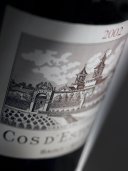Château Cos d'Estournel
Related products
Laurent Ponsot Bourgogne Blanc Cuvée Du Perce Neige
Laurent Ponsots new company is a stage in a wide-ranging project that began four decades ago. In this different format, Laurent Ponsot continues to use his experience, his craftsmanship and his passion to serve the terroir of Burgundy. The company Laurent Ponsot is neither a domain nor a maison: its a state of mind. To create an exceptional wine is the equivalent of designing luxury goods. Haute couture is how we have decided to describe these incredible wines, like unique designer pieces, made even more glorious through our experience and craftsmanship. The freshness and fruity and accessible suppleness of a Bourgogne Blanc make it the perfect introduction to the stunning wines of Laurent Ponsot.
Château Corbin
Chateau De Ferrand
Château Les Ormes de Pez Saint-Estephe
A truly serious Bordeaux from the Saint Estephe appellation in the Northern Medoc. Dominated by tannin and acid at the moment, it will fill out to reveal all it's velvety richness in years to come.
Château d'Arche Sauternes
Château d'Arche is an important part of Sauternes history with winemaking dating back to the 16th century. New treatments to the wines including maturing the wine for at least two years in casks, 40% of which are new help produce a wine of utmost concentration. The 2009 d'Arche is a seriously powerful wine with copious characters of marmalade, apricot and dense pineapple. Capturing the vintage perfectly, this is a Sauternes that requires a deeply flavoured cheese accompaniment.
Château Chasse-Spleen
Marsau (BIO ORGANIC)
Château Marsau's 2018 Marsau (BIO ORGANIC) Francs-Côtes de Bordeaux is a true testament to the terroir of Bordeaux. This beautifully crafted wine showcases the region's unique climate and soil with every sip. The deep ruby hue entices the senses and leads to a bouquet of blackcurrant, plum, and subtle herbal notes. On the palate, the wine reveals luscious layers of dark berries, complemented by hints of vanilla and spice from its time in oak barrels. The tannins are well-integrated, providing a smooth and elegant mouthfeel. The finish is long and lingering, leaving a touch of minerality on the palate. This 2018 vintage truly captures the essence of Château Marsau's commitment to organic and sustainable winemaking practices. A perfect pairing with red meat dishes or a selection of aged cheeses. Undoubtedly, this wine will continue to evolve gracefully for years to come.
Château Doisy-Daëne Sauternes
The 2001 Doisy Daëne Sauternes is a perfect match to apple crumble and double cream. This example shows lovely hints of marmalade and citrus on a palate that is sweet but not cloying.



















